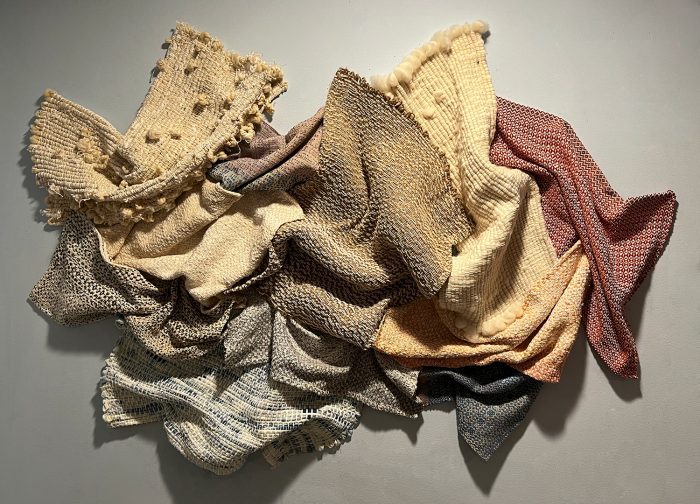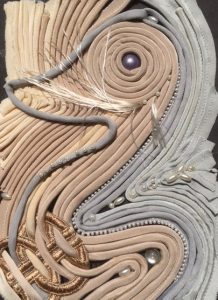WICKED WEATHER
Ava Stecker was in the right place at the right time when she snapped this cool photo of storm clouds rolling in over Port Jefferson Harbor on July 16.
Send your Photo of the Week to [email protected]
WICKED WEATHER
Ava Stecker was in the right place at the right time when she snapped this cool photo of storm clouds rolling in over Port Jefferson Harbor on July 16.
Send your Photo of the Week to [email protected]

Huntington Summer Arts Festival
The 57th annual Huntington Summer Arts Festival continues at the Chapin Rainbow Stage at Heckscher Park, 2 Prime Ave., Huntington this week with Lakecia Benjamin & Pursuance on July 21, Bria Skonberg on July 22, Kendace Springs on July 23, Diva Five Play on July 24, Huntington Community Band on July 27 and Miko Marks & The Abrams on July 28. All shows start at 8 p.m. Bring seating. Free. See children’s shows on page B23. For more information, visit www.huntingtonarts.org.
Huntington Manor Fireman’s Fair
Long Island’s largest Fireman’s Fair is held at the Henry L. Stimson Middle School, 401 Oakwood Rd., Huntington Station, and adjoining Peter Nelson Park today from 6 to 11 p.m., July 22 from 6 p.m. to midnight and July 23 from 5 p.m. to midnight. (Parade on July 20 at 7:30 p.m.) Featuring amusement rides, games, food, music and gambling. Fireworks every night at 9:30 p.m. P.O.P bracelets for the rides are $30. Questions? Call 427-1629, ext. 4.
Smithtown Library concert
The Dennis Cannataro Family Summer Concert Series returns to the Smithtown Main Library, 1 North Country Road, Smithtown tonight at 7:30 p.m. with Petty Rumors featuring the music of Fleetwood Mac and Tom Petty. Bring a chair or blanket for seating. For more information, call 360-2480 ext.150 after 3 p.m.
Shark lecture
The Whaling Museum of Cold Spring Harbor presents a virtual lecture titled Sharks of Long Island! at 7 p.m. Did you know sharks have existed longer than trees? Discover the range of magnificent and diverse shark species we share our local shores and waters with. Find out about shark myths and the histories of shark attacks in New York. Free, suggested donation $10. To register, visit www.cshwhalingmuseum.org.
Harborside Concerts
The Village of Port Jefferson continues its free Harborside Concert series at the Show Mobile at Harborfront Park, 101-A East Broadway, Port Jefferson with Southbound at 8 p.m. Bring seating. For more information, call-473-4724 or visit www.portjeff.com.
Community Band concert
The Northport Community Band continues its summer concert series at the Robert W. Krueger Bandstand in Northport Village Park tonight with a concert titled Harbor Jams at 8:30 p.m. The Northport Community Jazz Orchestra will open. Bring seating. Rain location is Northport High School. Call 261-6972 or visit www.ncb59.org
Huntington Manor Fireman’s Fair
See July 21 listing.
Happenings on Main Street
The Northport Arts Coalition presents a free concert by Paige Patterson at the Northport Village Park Gazebo at the harbor at 7 p.m. as part of its Happenings on Main Street Series. Bring seating. Call 827-6827 or visit www.northportarts.org.
Fleetwood Mac tribute
Theatre Three, 412 Main St., Port Jefferson continues its 2022 Summer Concert Series with Fleetwood Macked (Fleetwood Mac tribute band) at 8 p.m. Whether performing the Rumours album in it’s entirety or a decades show featuring Fleetwood Mac’s hits from the 70’s, 80’s, 90’s and today, every performance transports audiences to another time and place. Complete with costume changes, dialogue and video backdrops it’s a show not to be missed. Tickets are $59. To order, call 928-9100 or visit www.theatrethree.com.
Huntington Manor Fireman’s Fair
See July 21 listing.
Caumsett Hike
Caumsett State Historic Park Preserve, 25 Lloyd Harbor Road, Huntington will host a periphery 6-mile hike through the park from 9:45 a.m. to 12:45 p.m. Bring drinking water. Adults only. $4 per person. Advance registration required by calling 423-1770.
Port Paws Dog Festival
Call all dog lovers! The first annual Port Paws Dog Festival heads to the Joe Erland Baseball Field, Caroline Ave., Port Jefferson on July 23 and 24. The two-day festival will feature a Dock Dogs® aquatic competition, canine vendors, food trucks, activities, live music and more. Admission is $10 per adult, kids and canines are free. Call 473-4724 for more information.
WMHO’s Pop Up Saturday
The Ward Melville Heritage Organization continues its Pop-Up Saturdays at the Stony Brook Village Center with a concert by Brenda and Burke in front of the Stony Brook Post Office on Main Street from 2 to 4 p.m. and Silent Mind Tai Chi in the Inner Court from 3 to 4 p.m. Rain date is the following day. Free. Call 751-2244 or visit www.wmho.org for more information.
Dave Matthews Band tribute
The Suffolk County Vanderbilt Museum, 180 Little Neck Road, Centerport continues its Concert in the Courtyard series with a performance by Joyride – A Celebration of the Dave Matthews Band – from 7 to 10 p.m. Held rain or shine. Tickets are $30 per person at www.vanderbiltmuseum.org.
Tribute to the Beatles
Theatre Three, 412 Main St., Port Jefferson continues its 2022 Summer Concert Series with a tribute to the Beatles with Beatlemania at 8 p.m. This is your ticket to ride through the 60’s….with vintage musical equipment, impeccable vocals, authentic costumes and brilliant musicianship. Touring the world over for the last 20 years, Beatlemania Now recreates the music of the Fab Four, with a set list spanning from the Ed Sullivan Show straight through to the roof top concert from the film “Let it Be.” Tickets are $59. To order, call 928-9100 or visit www.theatrethree.com.
Port Paws Dog Festival
See July 23 listing.
Parading Down Main Street
The Northport Historical Society hosts a guided walking tour of Northport’s historic Main Street business district from 1:30 to 3:30 p.m. Using storytelling and historic photos from the society’s collection, your guide will make the past come alive! Tour leaves from the Society, 215 Main Street, Northport. Tickets are $7 per person. Call 757-9859 or visit www.northporthistorical.org to register.
Wind Down Sundays
The popular summer concert series continues at Hap’s historic Red Barn at Frank Melville Memorial Park, 1 Old Field Road, Setauket tonight with Carl Safina and A Moments Notice (jazz, classics) at 5:30 p.m. Bring seating. Call 689-6146 or visit www.frankmelvillepark.org.
Summer Concerts on the Green
Summer concerts are back in front of the Stony Brook Post Office at the Stony Brook Village Center, 111 Main Street, Stony Brook from 7 to 9 p.m. every Sunday through Aug. 21, courtesy of the Ward Melville Heritage Organization. Tonight’s performance will be by The Clusters (hits from the 50s to the 80s). Free. Bring seating. Call 751-2244 or visit wmho.org.
No events listed for this day.
Bird lecture
As part of its summer program series, Frank Melville Memorial Park, 1 Old Field Road, Setauket will present a lecture on bird decline and what you can do to stop it at the Red Barn at 11 a.m. Free. No registration necessary. For more information, call 689-6146 or visit www.frankmelvillepark.org
Northport Harbor Family Nights
The Northport Chamber of Commerce presents Northport Harbor Family Nights from 6:30 to 9:30 p.m. Main Street will be closed to traffic from Gunther’s to Skippers to allow for a classic car chow, bounce houses, live music by Somewhat Nautical and the Gold Coast Jazz Band, performances by School of Rock Huntington, magician Didi Maxx, a dance contest, outdoor dining and more. Come join the fun! Call 754-3905.
Concerts at The Gazebo
Enjoy Tuesday night concerts at The Gazebo, 127 Smithtown Blvd., Nesconset through Aug. 30 at 7 p.m., courtesy of the Nesconset Chamber of Commerce. Tonight’s performance will byvAllmost Brothers (Allman Brothers tribute band). Rain dates are the next day. Bring seating. Questions? Call 672-5197 or visit www.nesconsetchamber.org
Concerts in the Courtyard
Northport Public Library, 151 Laurel Road, Northport will host an outdoor concert in the courtyard featuring The Dedications at 7 p.m. Building on their rock and roll and doo-wop legacy, the band performs 50s & 60s harmony, ballads, and classic rock. Rain date is July 27. No registration required. Call 261-6930.
Community Band concert
The Smithtown Community Band concludes its 36th annual summer concert season at the Smithtown Historical Society’s Brush Barn, 239 E. Main St., Smithtown at 8 p.m. This year’s theme is American Pop Culture: A Journey Through Time featuring music attributed to popular books, movies, video games, television, advertising and Broadway shows of the 20th and 21st century. Free. Bring seating. Call 265-6768 for more info.
Summer Concert Wednesdays
The Port Jefferson Station/Terryville Chamber of Commerce continues its Summer Concert Wednesdays at the Port Jefferson Station/Terryville Chamber Train Car Park, Nesconset Highway and Route 112, Port Jefferson Station from 6 to 8 p.m. with School of Rock and a BMX Stunt Show (Ice Cream Night)). Call 821-1313 or visit www.pjstchamber.com.
Port Jefferson Sunset Concert
Greater Port Jefferson Arts Council presents Sunset Concerts at Harborfront Park, 101-A East Broadway, Port Jefferson every Wednesday from 6:30 to 8 p.m. through Aug. 31. Tonight’s performance will be by Blue Spirit. Bring seating. Call 473-5220 or visit www.gpjac.org.
Smithtown Library concert
The Dennis Cannataro Family Summer Concert Series returns to the Smithtown Main Library, 1 North Country Road, Smithtown tonight at 7:30 p.m. with Endless Summer (Beach Boys tribute). Bring a chair or blanket for seating. For more information, call 360-2480 ext.150 after 3 p.m.
Community Band concert
The Northport Community Band concludes its summer concert series at the Robert W. Krueger Bandstand in Northport Village Park tonight with a concert titled Family Finale at 8:30 p.m. with the traditional 1812 Overture with cannons fired. Opening act will be the Northport Schools SMARTSummer students performance. Bring seating. Rain location is Northport High School. Call 261-6972 or visit www.ncb59.org
‘The Biological Aging Challenge’
The Cinema Arts Centre, 423 Park Ave., Huntington will host a screening of Gary Null’s documentary, The Biological Aging Challenge, on July 24 at noon. If you felt certain that you could extend the longevity of your life by ten, twenty or even thirty years by making fundamental changes in your diet and lifestyle, would you have the inspiration to make those changes? Dr. Gary Null applied this hypothesis in observation clinical trials enrolling approximately 60 aging adults to monitor and measure whether this may be true. The results were astonishing. With Gary Null in person. Tickets are $15.
‘West Side Story’
The Village of Port Jefferson continues its Movies on the Harbor series at Harborfront Park, 101-A E. Broadway, Port Jefferson with a screening of West Side Story (1961) on July 26 at dusk. Rain date is the next evening. Bring seating. Free. Call 473-4724 or visit www.portjeff.com.
Stony Brook Film Festival
Stony Brook University’s Staller Center for the Arts, 100 Nicolls Road, Stony Brook will present the 2022 Stony Brook Film Festival from July 21 to 30 featuring independent features, documentaries and shorts, question and answer sessions with filmmakers and receptions. Fee is $20 evening pass, $125 festival pass. To order, call 632-2787. For the film schedule, visit , ww.stonybrookfilmfestival.com. See more on page B19.

‘Fast Times at Ridgemont High’
The Cinema Arts Centre, 423 Park Ave., Huntington will present a special screening of Fast Times at Ridgemont High on July 28 at 7:30 p.m. in honor of its 40th anniversary. This hilarious portrayal of Southern California high school students and their favorite subjects— sex, drugs, and rock ‘n’ roll—features a classic soundtrack that includes hits from The Go-Go’s, Oingo Boingo, and The Cars. Four decades later, Universal Pictures’ Fast Times at Ridgemont High remains as bold, daring and funny as it was a generation ago. Rated R. Tickets are $12, $10 seniors and students. Visit www.cinemaartscentre.org.
‘Every Brilliant Thing’
Theatre Three, 412 Main Street, Port Jefferson, in association with Response Crisis Center, presents the Long Island premiere of Every Brilliant Thing, a one-man show starring Jeffrey Sanzel, on the Second Stage Sundays at 3 p.m. from July 10 to Aug. 28. You’re seven years old. Your mother is in the hospital. Your father said she’s “done something stupid.” So, you begin a list of everything that is truly wonderful about the world—everything worth living for. With audience members recruited to take on supporting roles, Every Brilliant Thing is a heart-wrenching, hilarious story of depression and the lengths we will go for those we love. All seats are $20. Fifty percent of the gross proceeds of this production will benefit Response Crisis Center. To order, call 928-9100 or visit www.theatrethree.com.
‘On Your Feet!’
The John W. Engeman Theater, 250 Main St., Northport presents On Your Feet! The Story of Emilio and Gloria Estefan from July 14 to Aug. 28. From their humble beginnings in Cuba, Emilio and Gloria Estefan came to America and broke through all barriers to become a crossover sensation at the very top of the pop music world. But just when they thought they had it all, they almost lost everything. On Your Feet! takes you behind the music and inside the real story of this record-making, and groundbreaking couple who, in the face of adversity, found a way to end up on their feet. Get ready to get on your feet, and dance to the smash hits “Rhythm Is Gonna Get You,” “1-2-3,” “Live For Loving You,” “Conga,” and many more. Tickets range from $75 to $80 with free valet parking. To order, call 261-2900 or visit www.engemantheater.com.
‘Troilus and Cressida’
The Carriage House Players continues its annual Shakespeare Festival at the Suffolk County Vanderbilt Museum, 180 Little Neck Road, Centerport with Troilus and Cressida through July 24 (excluding July 22) on Wednesdays and Fridays at 8 p.m., Sundays at 7 p.m. Performances take place outdoors on stage in the courtyard, where the Spanish-Mediterranean architecture adds a touch of timeless charm and magic. Bring a picnic dinner to enjoy before the show and bring your own lawn chair. Inclement weather cancels. Tickets are $20 adults, $15 seniors and children ages 12 and under. To order, visit www.vanderbiltmuseum.org.
‘Spring Awakening’
Up next for Star Playhouse at Suffolk Y-JCC’s Stage 74, 74 Hauppauge Road, Commack is Spring Awakening, the Tony Award-winning rock musical adaptation of the seminal play about the trials and tribulations of growing up, on July 30 at 2 p.m. and 8 p.m. and on July 31 at 1 p.m. and 6 p.m. Tickets are $20, $15 seniors and students. To order, call 462-9800 x-136 or visit www.starplayhouse.com.
‘I Love You, You’re Perfect, Now Change’
The Smithtown Center for the Performing Arts, 2 E. Main St., Smithtown presents the hit musical I Love You, You’re Perfect, Now Change from Aug. 4 to Aug. 14. This hilarious revue pays tribute to those who have loved and lost, to those who have fallen on their face at the portal of romance, to those who have dared to ask, ‘Say, what are you doing Saturday night?’ Tickets are $45 adults, $40 seniors. To order, visit www.smithtownpac.org.
By Julianne Mosher
The Village of Port Jefferson is bringing a new meaning to the dog days of summer.
The Port Paws Dog Festival is gearing up for this weekend and it’s going to be dog-gone fun.

Kevin Wood, economic development director for the village and chair of the event, said the event will bring not only lots of business to Port Jeff, but also is an excuse to show some friendly competition for one furry friend to another. “The Dock Dogs competition is open to everyone,” he said while standing next to his 18-month-old English creme retriever, Brody.
The dogs go tail-to-tail in different exercises — the biggest being retrieving a lure fastest in a 30,000-gallon pool that will be set up at Joe Erland Field, on Caroline Avenue, near the new Barnum Avenue parking lot.
Wood said he first saw the competition while visiting the East End of Long Island, and soon realized he needed to bring it Down Port. “Port Jefferson is a dog-loving town,” he said.
The Wood family always had small, lap dogs who they loved — but when they adopted Brody, who loves the water, he thought it would be fun to see how he, and all the other local dogs, would do in a friendly competition.
“No municipality has done this before,” Wood said. “I wanted to bring it to the next level and bring it to the village.”
Presented by King O’Rourke Auto Group, the three-day event starts on Friday, July 22 with a mini event for non-competitors — a trial event for dogs willing to give it a shot. Dog owners interested in signing up can do so that day for a $20 registration fee, with the event beginning at 5 p.m.
On Saturday, July 23 and Sunday, July 24, from 9 a.m. until 5 p.m., dogs from all over Long Island, and even some flying in internationally, will complete on who can jump the highest, swim the furthest and retrieve a toy in the pool the fastest after jumping and diving off of a dock, to be built on the field, and into the giant pool.
The inaugural jump will be dedicated to Aida Ramonez, an 11-year-old Port Jefferson resident who passed away earlier this year. She was an avid animal lover who would have loved an event like this, Wood said.
Throughout the show, Dock Dogs will present the Big Air Wave competition accompanied by an Extreme Vertical and Speed Retrieve competition for both competitors and spectators to enjoy. The Big Air competition features dogs running down a 40’ dock and diving into a pool of water after an object, in which they are electronically judged for the length of their jump.
The Extreme Vertical competition is a “high jump” for the dogs as they each lunge to snag a “bumper” suspended in the air. With each grab, the height increases in two-inch increments until only one dog is crowned king.
Rounding out the action is the newest form of competition known as Speed Retrieve — where the dogs are put on the clock to see how fast they can run down the dock, jump into the water, swim to the end of the pool and retrieve an object which is held by a modified extender arm.
The competitions are open to any and everyone. Teams are made up of one dog and one handler. Your canine must be six months or older to be eligible. Canines of any breed, size or shape are welcomed. Not only is the competition open to all types of canines, but also handlers above the age of seven are welcomed. There is even a “Youth Handler” class for those who are between the ages of seven to 14.
But Wood said that the weekend-long event won’t just be for games — they decided to turn it into a full-blown festival with dozens of dog-centric vendors, rescues, trainers and some food trucks for their human companions.
“This is the first time in a long time that something attractive will be at this field,” Wood said, noting that he first brought the idea to the village more than eight months ago before it was officially voted on.
Mayor Margot Garant, who has a furry friend named Wyatt who will be in attendance, said that the village is excited to host this family event.
“Our dogs are integral members of our family and should be celebrated as such,” she said. “I can’t wait to see everyone there and to enjoy the comradery and competition.”
Tickets are $10 for entry, while children under 12 and dogs are free. Proceeds from the event will help fund the Port Jefferson Harbor Education and Arts Conservancy, with hope to bring new drinking fountains (for humans and dogs) to different locations around the village.
Wood added that the event will be livestreamed on Facebook, and shuttle buses will be circling all of the parking lots to help bring people to the event.
For more information and to purchase tickets, visit portpawsdogfest.com.

St. Johnland resident Chris Hasbrouck has put his free time into gardening with bountiful results. Sunflowers, eggplant, tomatoes, green beans, cucumbers and strawberries fill the raised garden beds outside of Lawrence Hall where Chris resides.
A former stockbroker, Hasbrouck, who is 55, suffered a stroke that left him in need of round-the-clock care. “My father had a vegetable garden, so when I was looking for a hobby, it just seemed like a natural choice,” he said.
Originally from Centerport, Hasbrouck started his gardening obsession 4 years ago and today has a crop of vegetables he shares with nurses and therapists at St. Johnland.
By Melissa Arnold
Stony Brook University’s Staller Center for the Arts turns into a movie lover’s mecca when new independent films screen at the Stony Brook Film Festival from Thursday, July 21 to Saturday, July 30. The popular event pairs memorable short films with an array of features you won’t see anywhere else, making it a favorite of moviegoers and filmmakers alike.
Now in its 27th year, the festival will celebrate its return to a fully live experience after some creative adjustments during the pandemic. Over the course of nine days, 38 films from 27 countries will be screened on evenings and weekends. But deciding what to show is no easy task.
More than a thousand films are sent to festival director Alan Inkles each year, he said. With the help of co-director Kent Marks, they go through an intense process of screening, debating, and cutting before the final selections are made.
The resulting collection showcases both shorts and feature-length films in all kinds of styles and genres. Among them is a short sci-fi comedy called The Switcheroo, directed by brothers and Stony Brook natives Ryan and Anthony Famulari. The film will be screened on Sunday, July 24 at 7 p.m.
“I try not to read anything about a film before I watch it — I owe it to our viewers to not favor anyone, so I’m not going to pick a film just because it’s local. We choose a film because it’s enjoyable,” Inkles explained. “That said, I love that we’ve been able to include Switcheroo and have Long Island represented. Comedy is hard to do, especially for young filmmakers, but this story is so charming, funny, and just really nailed it. And when I read that the brothers were from Stony Brook, I thought it was great.”
The Switcheroo stars Anthony Famulari playing both a heartbroken scientist and his charismatic clone. The clone tries to help his creator land a date, which reveals some surprising and funny secrets.
Cloning was the perfect concept to explore for the brothers, who were living together during the worst of the pandemic and looking for something fun to do.
“The idea was more of a necessity, considering we didn’t have a crew or a large budget,” said Anthony, 33. “But we wanted to make something that was still enjoyable and interesting. We both gravitate to stories with sci-fi elements, and it was a great solution to the creative challenges of the time.”
The brothers grew up with their own interests, but shared a deep love of movies and storytelling. Both went on to major in journalism at Stony Brook University. While there, Ryan played football and Anthony dove into theater. They also worked together conducting and filming interviews on campus, and wrote film scripts in their spare time.
“Anthony was always a ham, but I didn’t see him act for the first time until college. I found that he was really good at it,” recalls Ryan, 35. “This has been a passion for us for a long time. We’ll go see a movie and then get into a deep discussion about it for an hour after. Our filmmaking is like that too. We’ll wrestle over an idea, but that’s fun for us.”
These days, the Famularis are on separate coasts — Ryan went to grad school for creative writing and is currently living in New York working remotely for a Los Angeles-based animation studio, while Anthony lives in Los Angeles pursuing acting while also working for an animation studio. But they’re still writing together and looking forward to whatever comes next.
“We’re constantly bouncing ideas around, and with each one of our short films, we learn something new and continue to improve,” Anthony said. “At the end of the day, our goal is to create something enjoyable that’s worth people’s time, while pursuing our passions.”
Also of note during this year’s festival is a panel discussion on women in filmmaking, and a weekend celebrating the spirit of American-made indie films.
“We have a lot of female writers and directors represented here, and have since the festival first began,” Inkles said. “It was important for us to feature them in a special way, and provide a unique opportunity for conversation, both among the panelists and with the audience.”
The panel is an exclusive benefit open to those who purchase festival passes. A variety of options are available, including an opening weekend pass.
Many film screenings will also include a question and answer session with the filmmaker. “That’s what makes a film festival so interesting as opposed to just going to the movies — you get the chance to talk with the filmmakers directly and learn more about their process,” Inkles said.
The Stony Brook Film Festival will be held from July 21 through July 30 30 at Stony Brook University’s Staller Center for the Arts, 100 Nicolls Road, Stony Brook. Individual tickets and premium passes are available. For the full schedule and more information or to purchase tickets, visit www.stallercenter.com or call the box office at 631-632-2787.
This article was updated July 23, 2022.
Who doesn’t love sunflowers? The Night Heron Artists are offering their large group painting “Sunflowers” for sale. Currently on view on the second floor of the Port Jefferson Village Center, the beautiful unframed watercolor painting was created by over 22 artists and measures 22″ by 30.” Fifty percent of the proceeds on the sale of the painting will be donated toward the Ukranian cause. All offers will be considered. For more information, call Leslie at 631-744-3794.

Currently on view at the Huntington Arts Council’s Main Street Gallery is a fiber show titled Uncommon Threads. The juried exhibition opened on July 15 and runs through August 27.
The exhibition focuses on fiber arts in all its forms. Juror Patty Eljaiek invited artists to provide entries that included either fiber-based materials or unconventional materials used in typical fiber art techniques such as crochet, weaving, sewing, felting, embroidery, etc.

As a mixed media artist, Eljaiek exhibits nationwide, in galleries from New York to California. Her work reflects her experience as a first generation American immigrant focusing on themes of belonging and identity. She continues to explore traditional fiber arts to create new and evolving work incorporating repurposed materials.
“I am so very excited about this exhibit,” said Eljaiek. “The original concept was to highlight contemporary works that celebrate fiber, in all its forms. The selected works show a wide variety of techniques, subjects and materials. It is thrilling to see artists creating work specifically for this show and also inspiring to know that there are artists who are working with fiber arts today in so many different ways. The Uncommon Threads exhibit is a perfect example of why fiber arts is fine art.”
Exhibiting artists include Mara Ahmed, Eileen Bell, Mary Brodersen, Amanda Burns, Kathy Cunningham, Oksana Danziger, Sherry Davis, Barbra Ellmann, Alicia Evans, Josefina Fasolino, Veronica Haley, Marilyn Hamilton Jackson, Conor Hartman, Andrea Larmor, Samantha Lopez, Emily Martin, John Michaels, Claudia Monnone, Luda Pahl, Eileen Palmer, Bernadette Puleo, Lauren Singer, Lisa Stancati, Devlin Starr, Robert Stenzel, Kim Svoboda, Rebecca Vicente, Debra Fink Bachelder, Ann Marie Miller, Deborah Monteko and Cindy Russell.
“Huntington Arts Council prides ourselves in providing opportunities that inspire artists to showcase their work. Uncommon Threads is an exhibit that features the work of both up and coming and seasoned artists; many new to HAC,” said Kieran Johnson, Executive Director of Huntington Arts Council. “The use of fiber to convey a story, feeling or message is at its best in this exhibit. I hope you will stop by to experience the unique and impactful medium of fiber art.”
The Main Street Gallery, 213 Main Street, Huntington is open from Tuesday to Friday, 11 a.m. to 4 p.m. For more information, call 631-271-8423 or visit huntingtonarts.org.

The Long Island Seaport and Eco Center (LISEC) seeks boat building/race teams for its annual Sikaflex Quick & Dirty Boat Build Competition, sponsored by the Sika Corporation, to be held at Harborfront Park, 101 East Broadway, Port Jefferson on Aug. 13 and 14.
Now in its 11th year, the event provides would-be boat designers and builders to have a weekend of fun and showcase their creative skills and talents. Using only a provided supply of plywood, plastic cable ties, and Sikaflex/sealant, two member teams must build, paint and then paddle their design around the village dock in Port Jefferson Harbor located just offshore of Harborfront Park.
Boats will be assembled on Aug. 13 from 10 a.m. to 3 p.m., painted on Aug. 14 from 9 a.m. to noon and then participants will take part in a race the same day at 3p.m. Trophies will be awarded for first, second and third place and original design. Are you up for the challenge? Download an application at www.lisec.org. For more information, call Len at 631-689-8293 or email [email protected].
The John W. Engeman Theater, 250 Main St., Northport will present RENT School Edition on Monday, Aug. 1 and Tuesday, Aug. 2 at 7 p.m. The show is performed entirely by The John W. Engeman Studio’s audition-only elite Select Players.
The show, based loosely on Puccini’s La Boheme, follows a year in the life of a group of impoverished young artists and musicians struggling to survive and create in New York’s Lower East Side, under the shadow of HIV/AIDS.
Directed by Andrew McCluskey and choreographed by Becky Kalman, the cast features Lizzie Becker, Aidan Bento, Logan Borre, Kieran J. Brown, Richard Campbell, Gabe Cruz, Lizzie Dolce, Daniella Falco, Greta Frankonis, Giuliana Gallone, Finn Gilbert, Ariana Glaser, Tara Griffin, Jenna Hammelman, Derek Hough, Max Lamberg, Madison Loscalzo, Alexander Mahr, Angelina Miller, Mia Mirabile, Alexandra Mitnick, Zachary Podair, Madelyn Quigley, Samantha Regenbogen, Ari Spiegel, Jacqueline Winslow and Ray Zerner.
Tickets are $20 per person. To order, call 631-261-2900 or visit www.engemantheater.com.
Smithtown Township Arts Council has announced that the works of St. James artist John Hunt will be on view now through Sept. 9, 2022 at Apple Bank of Smithtown, 91 Route 111, Smithtown. The exhibition, part of the Arts Council’s Outreach Gallery Program, can be viewed during regular banking hours Monday – Thursday 9 a.m. – 4 p.m.; Friday 9 a.m. – 6 p.m.; Saturday 9 a.m. – 1 p.m.
A St. James resident for 45 years, John Hunt spent the majority of his life on Long Island with time away for military service and education. John holds a Bachelor of Fine Arts from SUNY New Paltz and a Master of Fine Arts from The School of The Art Institute of Chicago.
“I have always had an interest in representational art and our surroundings,” said Hunt. “From the first time I flew in a plane and looked down at the landscape from a high altitude I became fascinated by the views I was seeing. Our normal relationship to the earth is from the ground and limited by our personal elevation. The view from a high altitude reveals patterns of man’s imprints on the earth as well as nature’s own from erosion or geological events or under ocean formations.”
“I have been able to travel to many areas in our country, especially in the western part of the states. The landscapes and topography are fascinating and prompt me to look at those areas from a greater elevation, so I refer to Google earth to explore the places I have visited from a vantage point way above the normal view. From that elevated position I search for patterns or formations that I find interesting and zoom in to select a view and adjust to arrive at a composition that I want to paint,” he said.
“STAC is grateful to Apple Bank for its continued support of culture in our communities. We are so happy to feature the talents of Long Island artists in this space!” said the press release.
For more information, call 631-862-6575.
